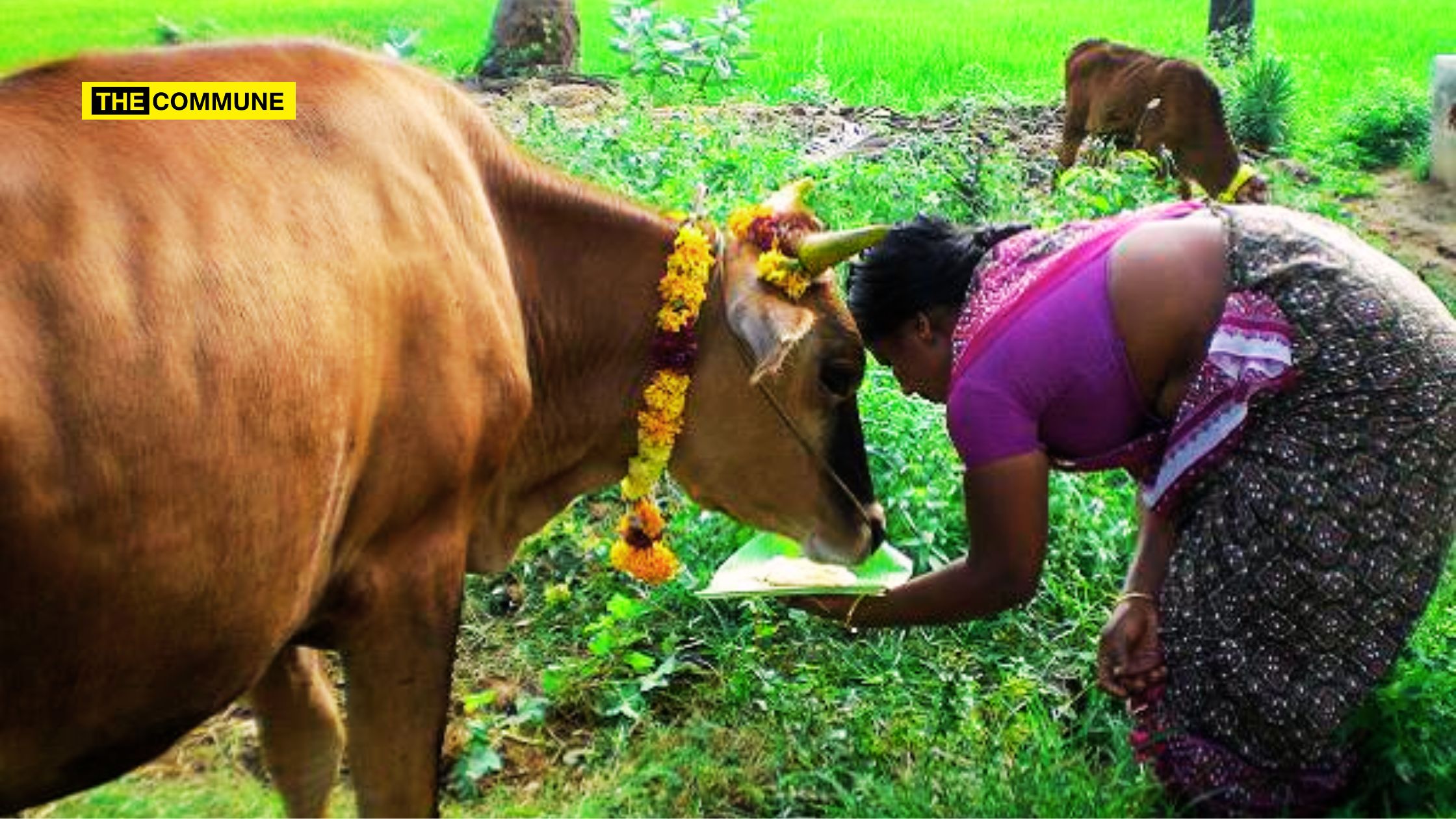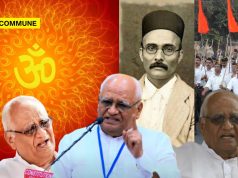
Tamil culture, with its rich tapestry of traditions, rituals, and deep-rooted beliefs, holds the cow in high esteem as a sacred and integral part of its heritage. From religious ceremonies to agricultural practices, the cow plays a significant role in shaping the cultural landscape of Tamil Nadu and the sacredness of the cow is woven into the very fabric of Tamil identity. The Tamil word for cow is pasu, which also means animal in Sanskrit. Thus, the cow personifies animals in general, sanctifying all animals. The cow stands as an enduring symbol of reverence, tradition, and interconnectedness in Tamil culture. As the culture continues to evolve, the deep-rooted respect for this gentle creature persists, serving as a testament to the enduring values that shape Tamil society.
This article explores various facets of the cow’s sacred status in Tamil culture, shedding light on practices like Maatu Pongal, Jallikattu, the use of cow-related products, and the cultural significance associated with the bovine presence in homes and temples.
1. Maatu Pongal: A Festival Of Gratitude
Every year, Tamilians and all South Indians, as a part of Sankranthi festival, celebrate Maatu Pongal, a unique festival dedicated to expressing gratitude to the cows for their indispensable contribution to agriculture. This celebration goes beyond the conventional Pongal festivities, emphasizing the vital role that cows play in rural life. Devotees worship the cows with offerings, decorate them with colorful accessories, and express their gratitude for the nourishing milk they provide.
2. Jallikattu: A Traditional Sport And Cultural Spectacle
Jallikattu, a traditional bull-taming sport, is deeply ingrained in the cultural fabric of southern Tamil Nadu. While controversy surrounds this practice, proponents argue that it is a manifestation of the deep bond between humans and bulls. The event serves as a testament to the valor of both the participants and the revered animals, symbolizing the interconnectedness of man and beast in Tamil culture.
3. Sacred Cow In Rural Agriculture
The significance of the cow in Tamil culture can be traced back to ancient times. The Tamils, one of the oldest surviving civilizations, have maintained a close relationship with agriculture and animal husbandry. The cow, as a domesticated animal, played a pivotal role in the agrarian economy of ancient Tamil society. Its contribution to plowing fields, providing dairy products, and serving as a source of manure for fertilizing crops solidified its status as a symbol of sustenance and prosperity.
In rural Tamil Nadu, agricultural families consider the cow and its milk highly sacred. Offering cow’s milk to temples is a common practice, signifying the importance of this gentle creature in sustaining life. Mistreating a cow is viewed as a serious offense, and immediate pariharam (atonement) is undertaken to seek forgiveness. This reflects the deeply rooted belief in the sanctity of the cow within the societal and religious framework.
4. The Cow In House Warming Event
In the unique cultural landscape of Kongu Nadu, the cow takes center stage even in the construction of homes. During housewarming ceremonies, the cow is the first to enter the newly built home, symbolizing prosperity and abundance. Additionally, the application of cow dung, especially from native breeds, on floors and open spaces is a traditional practice that persists even in modern homes, connecting the present to the architectural heritage of the past.
5. Saamy Maadu: The Sacred Bull In Temple Towns
Amman Temples in villages across Kongu Nadu house a sacred bull known as ‘Saamy Maadu’ (God’s bull). This revered creature roams freely without a leash and is allowed to graze in farmlands. Rather than viewing its presence as a nuisance, farmers feel blessed when the bull feeds on their crops, reinforcing the symbiotic relationship between humans and animals. This scene can also be seen in all major temple towns of Tamil Nadu.
6. Gosaalai And Temple Mutts
Institutions like the Isha Foundation in Coimbatore and various temple maths across Tamil Nadu maintain gosaalais, dedicated spaces for cows. These institutions recognize the spiritual significance of the cow and provide shelter and care for these sacred animals, underscoring their commitment to upholding cultural values.
7. Death Of A Cow: A Grief-Stricken Ritual
The death of a cow is treated with the same reverence as the passing of a family member in Tamil culture. Villagers visit the homes of the owner to offer condolences and support, highlighting the emotional connection between humans and cows. In Kongu Nadu villages, the last rites for a deceased cow are conducted with solemnity, mirroring the rituals observed for human members of the community.
8. Literary References: Manu Needhi Cholan And Chandeshvara Nayanar
Tamil literature provides evidence of the profound respect accorded to cows. Manu Needhi Cholan, a legendary king, went to the extent of sacrificing his own son to ensure justice for a cow. Similarly, Chandeshvara Nayanar, in a poignant display of devotion, cut his father’s leg when the latter interrupted his worship of the Nandi.


9. Nandi In The Sri Lankan Tamil Flag
The Sri Lankan Tamil flag contains picture of a Nandi (holy Bull), which symbolizes the deep-rooted connection between Saivism and the sacredness of the bull in Tamil culture. This representation underscores the enduring influence of cultural and religious practices beyond geographical boundaries.
10. Nandi And Linga Worship
The ritualistic worship of Nandi and lingas, as seen in Chandeshvara Nayanar’s story, is a central aspect of Tamil Shaivite practices. Linga worship symbolizes the formless nature of the divine and the devotee’s direct connection with the cosmic energy.
11. Lord Kamadhenu: Deity Of Plenty And Fulfiller Of Desires
In Tamil Nadu, Lord Kamadeenu is venerated as the divine giver of plenty and the fulfiller of all desires. Often depicted as a celestial cow, Kamadeenu symbolizes abundance, prosperity, and the benevolent fulfillment of the wishes of the devotees. The cow’s sacred status is thus elevated to a spiritual plane, reinforcing the cultural and religious significance of the bovine in the hearts of Tamil devotees.
12. Gopuram: The City Of The Cow In South Indian Temples
The intricate entrance gateways of South Indian and Southeast Asian temples, known as gopurams, find their roots in the early Vedic tradition. Originally designed to prevent cattle, including sacred cows, from wandering away, these gates evolved into elaborate structures that now serve as iconic features of temple architecture. The gopuram, with its ornate carvings and towering presence, stands as a symbolic representation of the divine city of the cow. The transition from the original wooden gopurams to stone structures, replicated even in places like Sanchi and reaching as far as China and Japan, underscores the enduring influence of this cultural motif.
13. The Cow And Constellations (Nakshathirams)
In Tamil culture, the cow is associated with specific constellations or nakshathirams, namely Avittam and Uthirattathi. These celestial connections add a layer of cosmic significance to the cultural reverence for the cow. The alignment of the cow with these constellations highlights the integration of celestial elements into the everyday fabric of Tamil life, emphasizing the interconnectedness between the terrestrial and the divine.
Mohit Kumar is a freelance writer.
Subscribe to our channels on Telegram, WhatsApp, and Instagram and get the best stories of the day delivered to you personally.




